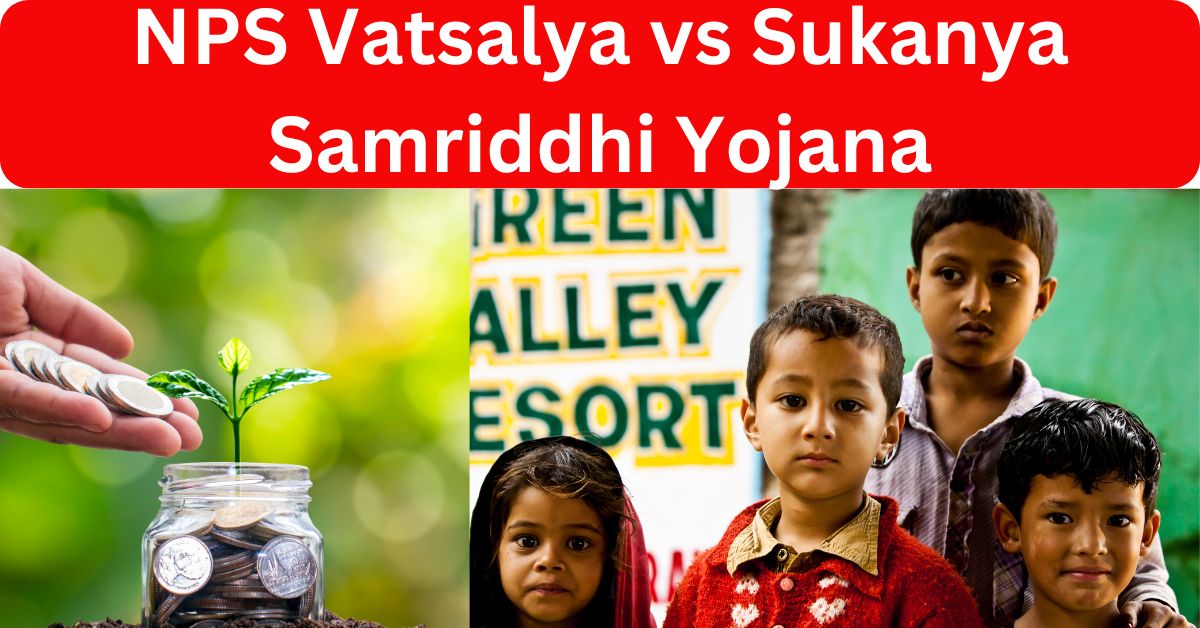Introduction
In her Budget 2024 speech, Finance Minister Nirmala Sitharaman proposed introducing a new scheme, NPS Vatsalya. This scheme is designed to be a National Pension Scheme (NPS) for minors, allowing parents to contribute on behalf of their children to secure their future. In this post, we will compare the NPS Vatsalya vs Sukanya Samriddhi Yojana to help you understand their features, benefits, and how they cater to different financial goals.
What is NPS Vatsalya?
Overview
The NPS Vatsalya Scheme, proposed in Budget 2024, allows parents and guardians to start a National Pension Scheme (NPS) for their children. This scheme enables the opening of an NPS account for minors, with contributions made by parents or guardians until the child reaches 18 years. At 18, the account can be converted into a standard NPS account, managed independently by the child.
Eligibility Criteria
- Who can open an NPS Vatsalya account? All Indian citizens, NRIs, or OCIs can open an NPS Vatsalya account for their minor children.
- Requirements for parents and guardians: There are no specific restrictions other than being a legal guardian or parent of the child.
Key Benefits
- Financial security for minors: Contributions made during the child’s minor years can lead to a significant retirement corpus.
- Portability and retirement benefits: The scheme offers portability and can be converted into a regular NPS account, providing benefits throughout the individual’s lifetime.
- Encouraging early savings habits: By starting savings early, the account promotes disciplined saving habits and a substantial retirement fund.
Applicability
- Who can apply for NPS Vatsalya? Any parent or guardian of a minor child can apply.
- How it fits into the broader NPS framework: The scheme is a variant of the standard NPS, tailored for minors and ensures a smooth transition to a regular NPS account upon reaching adulthood.
How to Open an NPS Vatsalya Account
- Expected process and requirements: The government will likely provide an application process through the official eNPS website or banks’ internet banking portals.
- Steps to apply and contribute: Follow the instructions provided by the government or authorized institutions for account opening and contributions.
What is Sukanya Samriddhi Yojana?
Overview
The Sukanya Samriddhi Yojana (SSY) is a government-backed savings scheme for the benefit of the girl child. It is designed to promote the education and marriage savings of a girl child and offers various tax benefits and attractive interest rates.
Eligibility Criteria
- Who can open a Sukanya Samriddhi account? The account can be opened by a guardian in the name of a girl child who is below 10 years old.
- Age and documentation requirements: The girl child must be under 10 years of age at the time of account opening, with necessary documentation including a birth certificate.
Key Benefits
- Tax benefits and interest rates: Deposits qualify for tax deductions under Section 80-C of the Income Tax Act, and the interest earned is tax-free.
- Savings for higher education and marriage: Withdrawals are allowed for educational purposes and in case of the girl’s marriage after the age of 18.
- Long-term financial growth: The scheme has a maturity period of 21 years, which helps accumulate a substantial amount.
Applicability
- Who can benefit from the Sukanya Samriddhi Yojana? The scheme benefits families with a girl child, encouraging long-term savings.
- Comparison with other financial schemes: SSY is distinct from other savings schemes due to its specific focus on girl children and the benefits tied to education and marriage.
How to Open a Sukanya Samriddhi Account
- Process and requirements for opening an account: The account can be opened at authorized banks or post offices with the necessary documentation.
- Deposit and withdrawal rules: The account requires a minimum deposit of ₹250 and allows withdrawals under specified conditions.
NPS Vatsalya vs Sukanya Samriddhi Yojana
Comparative Analysis
- Similarities between the two schemes(NPS Vatsalya Vs Sukanya Samriddhi Yojana): Both schemes aim to provide financial security for minors and have tax benefits.
- Differences in benefits and features: NPS Vatsalya focuses on retirement savings and portability, while Sukanya Samriddhi Yojana emphasizes educational and marriage expenses with specific withdrawal rules.
Financial Goals and Suitability
- Which scheme is better for different financial goals? NPS Vatsalya is suitable for long-term retirement savings, whereas Sukanya Samriddhi Yojana is ideal for educational and marriage savings for a girl child.
- Suitability based on child’s age and future plans (NPS Vatsalya Vs Sukanya Samriddhi Yojana): Choose based on the child’s age and the intended use of funds, such as education or retirement.
Tax Implications
- Tax benefits under NPS Vatsalya: Contributions are eligible for tax benefits under Section 80-C, and the scheme offers long-term retirement benefits.
- Tax benefits under Sukanya Samriddhi Yojana: Deposits qualify for tax deductions under Section 80-C, and the interest earned is tax-free.
Flexibility and Access
- Flexibility in contributions and withdrawals: NPS Vatsalya allows contributions until the child turns 18, whereas Sukanya Samriddhi Yojana has specific withdrawal rules for education and marriage.
- Access to funds and account management: NPS Vatsalya accounts are managed independently after the child turns 18, while Sukanya Samriddhi accounts have restrictions on withdrawals until maturity.
FAQs
What are the main differences between NPS Vatsalya and Sukanya Samriddhi Yojana?
The main differences lie in their purpose and benefits. NPS Vatsalya is geared towards building a retirement corpus, while Sukanya Samriddhi Yojana focuses on saving for education and marriage.
Can I open both NPS Vatsalya and Sukanya Samriddhi Yojana accounts for my child?
Yes, you can open both accounts for your child, depending on your financial goals and requirements(NPS Vatsalya Vs Sukanya Samriddhi Yojana).
How does the interest rate compare between NPS Vatsalya and Sukanya Samriddhi Yojana?
Interest rates for both schemes are set by the government, with Sukanya Samriddhi Yojana offering a fixed rate that may be higher than the interest rate for NPS Vatsalya.
What are the tax benefits of NPS Vatsalya?
NPS Vatsalya offers tax benefits under Section 80-C of the Income Tax Act, and the retirement corpus is subject to tax benefits on maturity.
How can I convert an NPS Vatsalya account to a standard NPS account?
Once the child turns 18, the NPS Vatsalya account can be seamlessly converted into a standard NPS account, allowing the child to manage it independently.
When can I withdraw funds from a Sukanya Samriddhi account?
Funds can be withdrawn for educational purposes once the child turns 18 or has completed the 10th grade. Withdrawals are also allowed upon marriage after the age of 18.
NPS Vatsalya: A Comprehensive Guide to Eligibility, Benefits, and Online Application
NPS Vatsalya Vs Sukanya Samriddhi Yojana
Both NPS Vatsalya Vs Sukanya Samriddhi Yojana offer valuable benefits for securing your child’s financial future. Choosing between them depends on your financial goals, whether you prioritize long-term retirement savings or educational and marriage expenses. Understanding the features, benefits, and tax implications of each scheme will help you make an informed decision.










